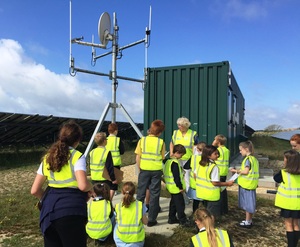
PJS visit to West Solent Solar Farm
Published on 2015-07-21 by Gill Hickman
Rising stars experience the power of the sun
Pennington Junior School’s EcoSquad enjoyed an visit to West Solent Cooperative solar farm on the penultimate day of the summer term. The 2.4MWp solar farm hides behind hedgerows in Lower Pennington Lane quietly reducing our carbon emissions, boosting local biodiversity and most definitely enhancing the UK’s energy security. This is a cooperative solar farm, one that is owned by the community. The visit was highly appropriate for PJS Eco Squad as children had learnt of the effects of excess carbon dioxide in the atmosphere. Thee was not much time as children had to return to school for an awards assembly. Nevertheless, children enjoyed a visit that enhanced their learning was enhanced and stretched their thinking.
Children were taken onto the site which was a former gravel pit that had later been used for landfill, perfect for a solar farm. Solar Century, the contractors chosen for installation, were kind to schools and arranged for a child height model solar panel to be linked to a meter. The children heard how electrons are part of atoms and they become excited when exposed to the sun. No power was generated when the sun shining on the panel was obscured by cardboard. The children, of course, predicted this! Here they learnt that the solar photovoltaic (PV) effect was first discovered in 1839.
Land between the solar panels has been planted with a mix of wildflowers and grass although with the exception of chamomile, wildflowers were not particularly abundant. A plant commonly found on Pennington marshes had not been seeded but fascinated children. This was the teasel whose large leaves had impressive upward pointing spines!
Children were taken onto an observation mound that had been created from spoil a year ago, and there they had a great view over the entire solar farm. Almost all of the 9372 solar panels were visible. This mound had also been seeded by Hampshire and Isle of Wight Wildlife trust and here success was more in evidence Species such as vetch, poppy, buttercup, echium and birds foot trefoil, had been carefully chosen to ensure maximum benefit for wildlife. And for Pennington Junior, this was important: they loved finding cinnabar moths, meadow brown butterflies, ladybirds and bees.
The youngsters left the mound to inspect an inverter, a device that converts DC current into AC, a difficult concept for children to grasp. Enthusiasts were asked to find out what this meant! They learnt how inverters gather the electricity generated by strings of solar panels and that distribution boards take power from the inverters. Lots of multiplication was involved here to the delight of some of the older pupils! Finally they were shown a transformer takes all electricity from the distribution boards converting it from low voltage to high voltage. One curious student was challenged to find out what a 'step up' transformer was! There were cables of all diameters for the children to inspect with cable diameter increasing at each successive stage. The fattest cable, going to the substation, was extremely heavy and children were suitably impressed. They learnt (if they did not know already) that copper is heavier than aluminium so one cable made of copper was heavier than three made of aluminium. They also quickly understood the notion of copper being a good conductor of electricity. “And a conductor of heat” one child correctly murmured!
More science followed! Children were shown the cables that take electricity into the National Grid at 11kV. “Such a simple connection” reported one lad as he looked at the three simple wires joining the overhead high voltage lines. The function of pyranometers, security cameras and a satellite dish were explained, and youngsters learnt how internet and global communications rely on solar-powered satellites orbiting the Earth.
The PJS children were blessed with some fine summer sunshine after a dismal day of drizzle the previous day. The sunny conditions of the July morning meant that the solar farm was generating nearly 2 megawatts of electricity, enough to boil about 700 kettles, or to power around two million mobile phone chargers. Children much enjoyed this figures!
Before returning to their minibus, children were shown the trees planted by Lymington Transition volunteers that had been donated by the Woodland Trust. They were also interested to see that beehives have been installed on site. The output performance figures for the solar farm can now be viewed live online and this means that the science can very definitely be taken back to school and shared with others. This is important to PJS that is working hard towards highly sustainable practice. The youngsters really enjoyed their visit and it is to the credit of their school and their teachers that they understood so much and asked such intelligent questions.
Children were given a small energy booty bag at the end of their visit, a fitting ‘thank you’ for an Eco Squad that has done so much for the school this year.
